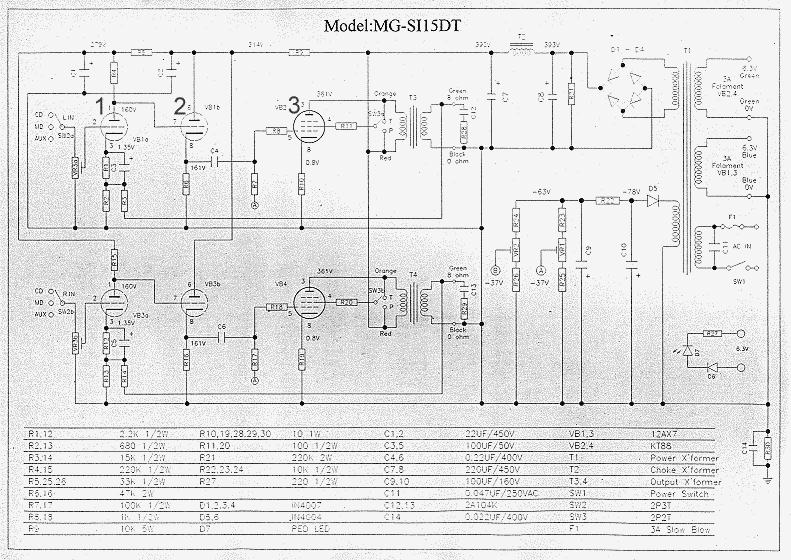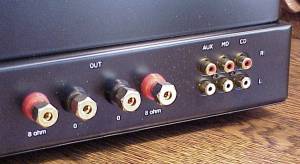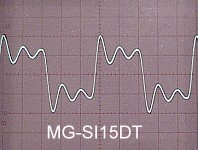Product Review - Antique Sound Lab
MG-SI15DT Single Ended Integrated Tube Amplifier -
January, 2001
John
E. Johnson, Jr.
![]()
|
|
Antique Sound Lab MG-SI15DT
Integrated Tube Amplifier - Single Ended, Pure Class A Operation Rated Power: 5 Watts RMS Per Channel into 8 Ohms in Triode Mode, 15 Watts RMS Per Channel in Tetrode Mode THD: < 2.5% at 5 Watts S/N: 78 dB MFR: 17 Hz - 28 kHz ±1 dB at Full Output Size: 7 3/4" H x 19" W x 18 1/4" D Weight: 25 Pounds MSRP: $699 USA
|
|
Antique Sound Lab; Distributed by Divergent Technologies, 342 Frederick Street, Kitchener, Ontario, Canada N2H 2N9; Phone 519-749-1565; Fax 519-749-2863; E-Mail [email protected]; Web http://www.divertech.com |
Introduction
Although tube amplifiers have enjoyed a renaissance in the recent years, the problem has been affordability, in particular, single-ended designs. This prevents would-be tube novices from becoming involved. Not so anymore. Antique Sound Labs amplifiers are manufactured in China and sold in the West by Divergent Technologies (Canada). Not only are the products inexpensive, but you can even get the preamplifier and power amplifier all in one chassis, still all single-ended and Class A, for much less than $1,000, which puts it in the range of just about everyone to try out.
As a short reminder, here is what single-ended means. Look at the schematic of the 15DT below (© Antique Sound Lab). The top half of the diagram is one channel. and the bottom half is the other channel. For the top channel, the parts labeled 1 and 2 are each a triode, but they are both housed in one glass envelope, called a dual triode, which in this case is a 12AX7. These two triodes are the input stage and driver stage respectively. The output stage is a 6550 or KT-88 beam power tetrode tube, which is wired here as a triode, with a toggle switch to make it operate as a tetrode. The tetrode beam power tubes have extra plates attached to the grid to give a more efficient operation. Single-ended means that each triode all in a row handles both the positive and negative portions of the electronic signal (music). This contrasts with a push-pull amplifier where one triode would handle the positive portion, and another triode would handle the negative portion. In a schematic, it would sort of look like tubes 1, 2, and 3 were for the positive, and the identical tubes in the bottom half of this diagram were for the negative, all in one channel. Purists feel that single-ended is best, because it avoids a certain kind of distortion that arises when the signal crosses over from the positive part of the circuit to the negative, and also because going to push-pull will increase the amount of odd-ordered harmonics in relation to the even-ordered ones.

A second reason I am showing
this schematic here, and perhaps the main reason, is so you can see how few
parts there are in this amplifier, even though it has both the preamplifier
and power amplifier. The table at the bottom of the schematic lists them all,
and the total is only 63, not including the tubes! This is undoubtedly another
reason tube amps sound so good. There is very little in the signal path. So,
why are tube amplifiers so expensive? Because not very many of them are
manufactured, and it is usually small shops that make them.
Single-ended triode amplifiers don't have much power output, especially if there is only one output tube. In this case, it is 5 watts per channel. That is why the tube chosen for this product is 6550, which allows the choice of using it in triode mode, or tetrode mode. A toggle switch on the chassis is used to change it from triode operation to tetrode. To do this, you power it off first, then switch it, then turn it back on. The switch is marked "T" for Triode and "P", because two "T"s would be pretty confusing. However, the "P" will have to stand for "Beam Power", because the instruction manual mistakenly calls it pentode. A photo of the toggle is shown at left.
The front has an on/off toggle, a rotary knob to select from three inputs, and a rotary volume control. The rear panel sports heavy gold-plated speaker binding posts and RCA jacks for the three sets of inputs.
I tested the 15DT with a Sony
carousel CD player, Perpetual Technologies P-3A DAC (TOSlink input), and
Monitor Audio Studio 20 SE speakers, all wired with Nordost cables. The Studio
20s are two-way floor-standing speakers, and although they are only modestly
sensitive (89 dB/w/m), they sound spectacular with tube amplifiers. I found
that I liked the triode mode on the 15DT better than the tetrode mode, and
that 5 watts per channel was plenty for the chamber classical music that I
like to listen to. In fact, we usually only are listening to our hi-fi with a
few watts on average. The dynamic requirements of Stallone films would
obviously not be met with the 15DT, but that is not its purpose. This is a
sitting by the fire with your eyes closed kind of product.
The Studio
20s are two-way floor-standing speakers, and although they are only modestly
sensitive (89 dB/w/m), they sound spectacular with tube amplifiers. I found
that I liked the triode mode on the 15DT better than the tetrode mode, and
that 5 watts per channel was plenty for the chamber classical music that I
like to listen to. In fact, we usually only are listening to our hi-fi with a
few watts on average. The dynamic requirements of Stallone films would
obviously not be met with the 15DT, but that is not its purpose. This is a
sitting by the fire with your eyes closed kind of product.
Compared to my reference setup, which includes a Balanced Audio Technology VK-5i tube preamplifier and VK-75SE tube power amplifier, the 15DT does not have the detail, but it does have the lush warm midrange. When I cranked it up to overload, the sound became mushy, but not irritating. This is another characteristic of single-ended tube amplifiers. It had a surprising amount of bass too, suggesting reasonable quality output transformers. In fact, the output transformers are the most expensive part of the design.
 Noise on the 15DT is very
low, in part due to the integrated design. I could hear no hum or hiss at
idle, with the volume set at mid-level. Using the triode mode, with a 10 kHz square wave input,
± 2 volts, the
output looks typical of single-ended designs, shown in the photo at left. The frequency response
started rising at 30 kHz to a peak at 55 kHz and then
declined. I found a 95 kHz oscillation in the tetrode mode, so I would
recommend only using the 15DT in triode mode, although it still sounds OK in
tetrode.
Noise on the 15DT is very
low, in part due to the integrated design. I could hear no hum or hiss at
idle, with the volume set at mid-level. Using the triode mode, with a 10 kHz square wave input,
± 2 volts, the
output looks typical of single-ended designs, shown in the photo at left. The frequency response
started rising at 30 kHz to a peak at 55 kHz and then
declined. I found a 95 kHz oscillation in the tetrode mode, so I would
recommend only using the 15DT in triode mode, although it still sounds OK in
tetrode.
This is less than stellar measurement results, but at $699 for the whole shebang, I was more concerned with how it sounded, and I was really quite pleased with the triode operation. The circuit has negative feedback, and you can see it in the schematic, where connections from the secondary winding of the output transformer go back to the input. The use of negative feedback may be responsible for the rising frequency response. We have talked about negative feedback on many occasions, and this circuit is an easy way to show what it looks like.
But, view it this way. The 15DT is an entry level tube product, at an entry level price, but is Class A and single-ended, which are two characteristics that tubophiles love. It's a bargain.
- John E. Johnson, Jr. -
![]()
© Copyright 2001 Secrets of Home Theater & High Fidelity
Return
to Table of Contents for this Issue.


